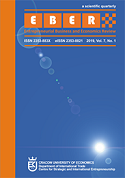Dynamic indexing and clustering of government strategies to mitigate Covid-19
Dynamic indexing and clustering of government strategies to mitigate Covid-19
Author(s): Jani Kinnunen, Irina Georgescu, Zahra Hosseini, Ane-Mari AndroniceanuSubject(s): Public Law, Economic policy, Health and medicine and law
Published by: Uniwersytet Ekonomiczny w Krakowie
Keywords: clustering; composite index; pandemic; public policy; Covid-19 mitigation;
Summary/Abstract: Objective: The objective of the article is to identify the reference group of countries with similar Covid strategies and other groups with their performance success, and to construct a composite Covid Mitigation Index for comparative purposes, thus, implying how to redesign the strategic policies. Research Design & Methods: Gaussian Mixture Modelling and Factor Analysis: the main design is quantitative, using Gaussian Mixture Modelling to find the optimal number of country clusters, and Factor Analysis with Principal Axis Factoring (FA-PAF) to build a composite index of governmental policies. Data includes eight mitigation policy variables and three supporting economic policy variables. Data are aggregated to form three periods and the cluster changes are identified by Gaussian Mixture Modelling. Then, the Covid Mitigation Index (CMI) is constructed by FA-PAF to obtain a comparative measure over the periods and the country clusters. The results were obtained by means of R studio and SPSS. Findings: The dynamic clustering leads to a decreasing number of clusters from nine clusters in the first period (January-February 2020), four clusters in the second period (March-April 2020), and two clusters in the third period (May-June 2020). In the first period, China (with CMI=48) took serious actions forming its own cluster, while 11 other countries (with CMI>10), e.g., early affected European countries such as Italy and Spain and large Asian countries such India and Indonesia, took moderate actions. In the second period all cluster averages were greater than China’s in the first period, i.e., most world countries were dedicated to fight Covid-19. In Europe, Italy, San Marino and France showed the highest CMI values, similarly to Iraq and Palestine in the Middle East, Peru and Honduras in the Latin America, and China, India and Indonesia in Asia. In the third period, cluster averages showed even tighter policies even though 42 countries had lower CMI values than previously. Implications & Recommendations: The approach provided a big picture for decision makers both in business and in governments. The key idea was to reveal reference groups of countries which help governmental actors to design and adapt their strategies over time by learning by their own experience and the results of the better performing clusters. It was suggested that a multi-criteria approach accounting for individual government’s preferences over health and economy is used along with the presented approach. Contribution & Value Added: Clustering with Gaussian Mixture Models and factor analysis based on Principal Axis Factoring for composite-index building were used. The methods are well-established, but they were applied in a novel way dynamically over time and for the composite CMI. CMI was built on two factors which identified the structure of mitigation policies and economic policies. The development of governmental polices over the first cycle of Covid-19 pandemic was described.
Journal: Entrepreneurial Business and Economics Review
- Issue Year: 9/2021
- Issue No: 2
- Page Range: 7-20
- Page Count: 14
- Language: English

